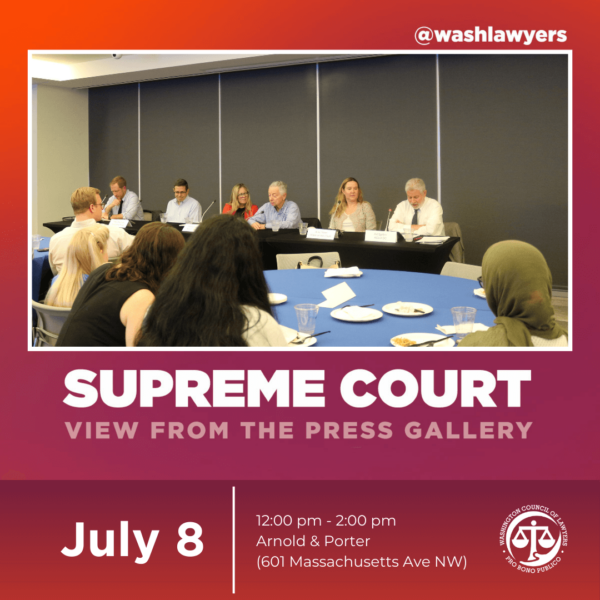
Supreme Court: View from the Press Gallery Recap
By Delphine Gareau
On July 8th, we welcomed a panel of distinguished journalists who have covered the Supreme Court for decades: John Fritze (CNN), Amy Howe (Howe on the Court and contributor to SCOTUSblog), David Savage (Los Angeles Times), Mark Sherman (Associated Press), and Abbie VanSickle (New York Times). Art Spitzer, Senior Counsel for the ACLU-DC, moderated the event. The conversation unveiled the Court both as an institution and a collection of individuals and how journalists cover the Court, particularly highlighting the 2023-24 term.
As our guests of summer associates, public interest and government attorneys, and law students settled in with lunch and coffee, the panel began discussing the implications of the Court’s most recent term. Although we had no deaths, retirements, nomination hearings, pandemics, or major case opinion leaks, this term was in no way boring. As was implied throughout the event, the 2023-24 term included landmark decisions that will have broad implications in the future. Savage joked that it seemed like the 4th of July because all the big bombs went off at the end. It is notable that while this Court has claimed it is one of law and not politics, the general American view of the Supreme Court under Roberts is that it has been based on politics and personal ideologies more than law.
The panelists responded to the question of Justice Sotomayor and Justice Kagan retiring under the Biden-Harris administration in order to secure two pragmatic seats on the Court for years to come. The panelists collectively agreed this would be irrational for the Court. Sherman pointed out that Justice Sotomayor and Justice Kagan are much younger than justices who retired in the past, like Breyer or Ginsburg, and have no pressing medical issues. Pushing judges out of their lifelong seats before they are ready to retire is a bad idea according to Savage as well.
Several changes to the Court were made during the COVID-19 pandemic and have remained ever since. For one, oral arguments are now broadcast through live audio which has been very beneficial for the media. Previously, Howe mentions, audio recordings were released at the end of the week. Sherman and VanSickle claimed that since technology isn’t allowed in the courtroom, live audio makes it more efficient for reporters to listen in rather than be present in the courtroom (which many would prefer). Mark said it makes his job less fun. The Court also adopted a new way of communicating their questions to counsel. Rather than a free-for-all method, the Court has adopted a system where the Chief Justice will ask the first questions followed by the other justices in order of seniority. This has had several effects including lengthening oral arguments and encouraging all justices to speak (Justice Thomas has become much more vocal since this procedural adjustment).
Our moderator, Art Spitzer, asked the panelists about whether or not the justices get along behind the scenes despite ideological differences. Sherman stated that the question is beside the point of the Court. However, it’s his sense that this Court does not experience the deeper friendships that have come out of past Courts, like for instance Justice Breyer and Justice O’Connor. Fritze added that Justice Thomas has said that past Courts have been much more of a family. VanSickle, explaining how Justice Sotomayor has cried after the Court laid down major decisions, opined that the focus should be on the substance and the impact of the decisions that have created an intense environment for the Roberts Court.
The conversation turned to the job of a reporter when they are not reporting on case decisions. The answer is mainly preparation. Sherman, Savage, and Vansickle all expressed that preparation for a case is everything. The majority of the spring is spent understanding the intricacies of the cases before the Court, reading about the laws behind each case, and knowing its broader implications on society. A part of the preparation is reading amicus briefs. Fritze said that he tries to read the most important amici, the ones that justice might ask about, that certain stakeholders take interest in, or anything that will make a good story. Sometimes amici briefs are the best way for a journalist to get to real people who are going to be affected by a case outcome.
Panelists led the audience through the chaos of decision day for a reporter. The Court’s press room is an intense environment. When a decision is released, there is a mad dash for the printouts followed by rapid typing for the purpose of live blog updates. Editors pressure writers to produce content quickly. However, as Savage points out, it’s better to publish slower with accurate information than to rush and risk being incorrect.
In the 2024 Supreme Court term there were seven oral dissents. An oral dissent is a mark of profound disagreement in the Court. Sherman commented that when a justice goes off script in these moments, that is when you will get the most color out of the Supreme Court and for that reason, these dissents make for interesting and important news stories. For VanSickle, the fact that each of the three liberal justices made an oral dissent in one of the administrative law cases this term was particularly notable.
The panelists concurred that Justice Barrett played a pivotal role this term. She dissented in the presidential immunity case, advocating for a much narrower ruling. Savage noted that her stance underscores her dedication to law over politics. VanSickle highlighted that Justice Barrett’s input would have been crucial in the EMTALA case (State of Idaho v. United States), potentially leading to a gender-divided vote on reproductive rights. Since her appointment, Justice Barrett has voted to overturn Roe v. Wade, end affirmative action, expand gun rights, and oppose a vaccine mandate for healthcare workers. Vansickle remarked that Justice Barrett remains a fascinating figure to observe on the Court.
Our discussion concluded with a few questions regarding the journalist’s top case lists for the 2023-2024 term. You can find these lists here:
The panel also discussed the implications of the groundbreaking cases of City of Grants Pass v. Johnson (2024) and Vidal v. Elster (2024), as well as the call for certain justice recusals during this term.
Special thanks to our host, Arnold & Porter, for providing us with a space for this event.
Delphine Gareau is Washington Council of Lawyer’s 2024 Summer Intern and a rising junior at Boston College.






